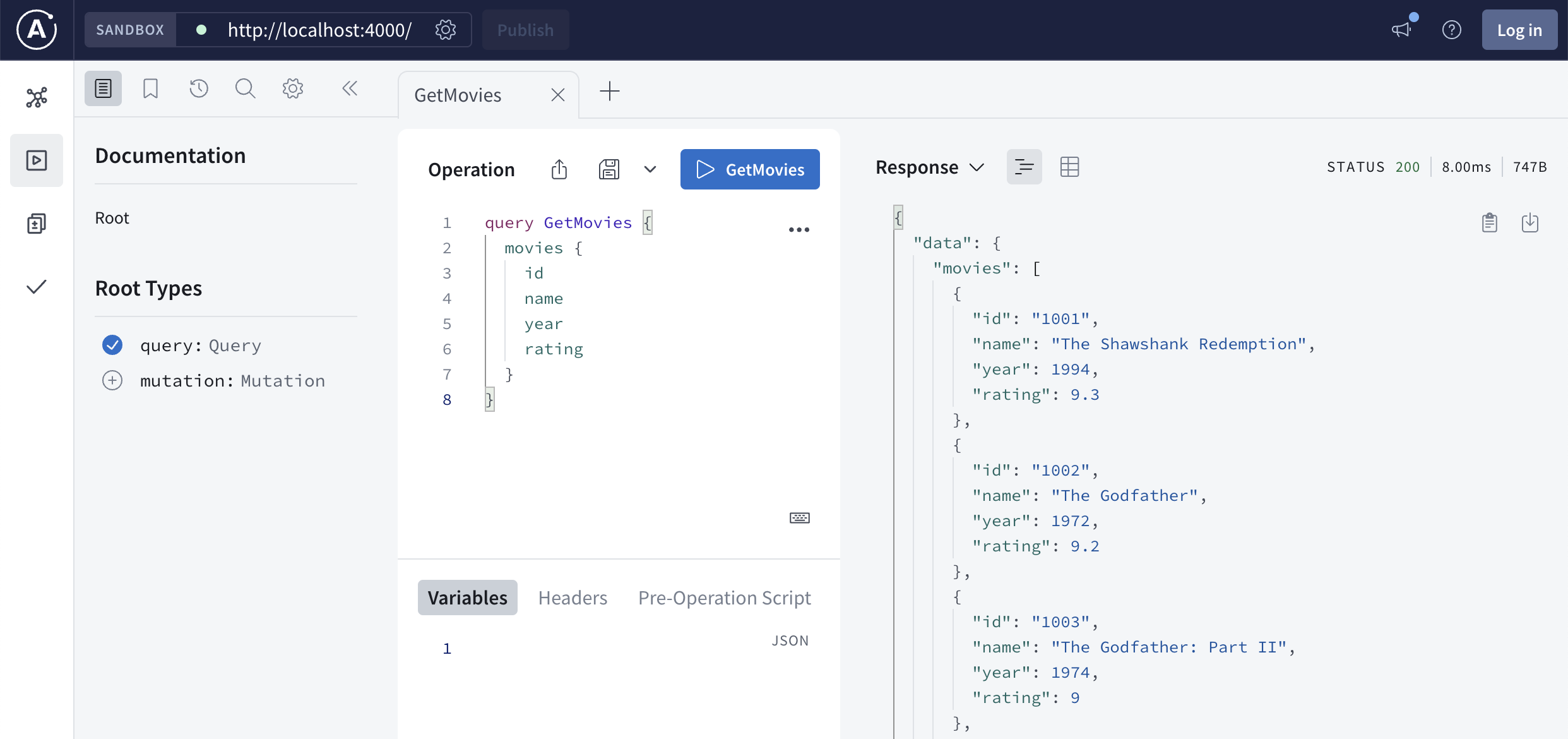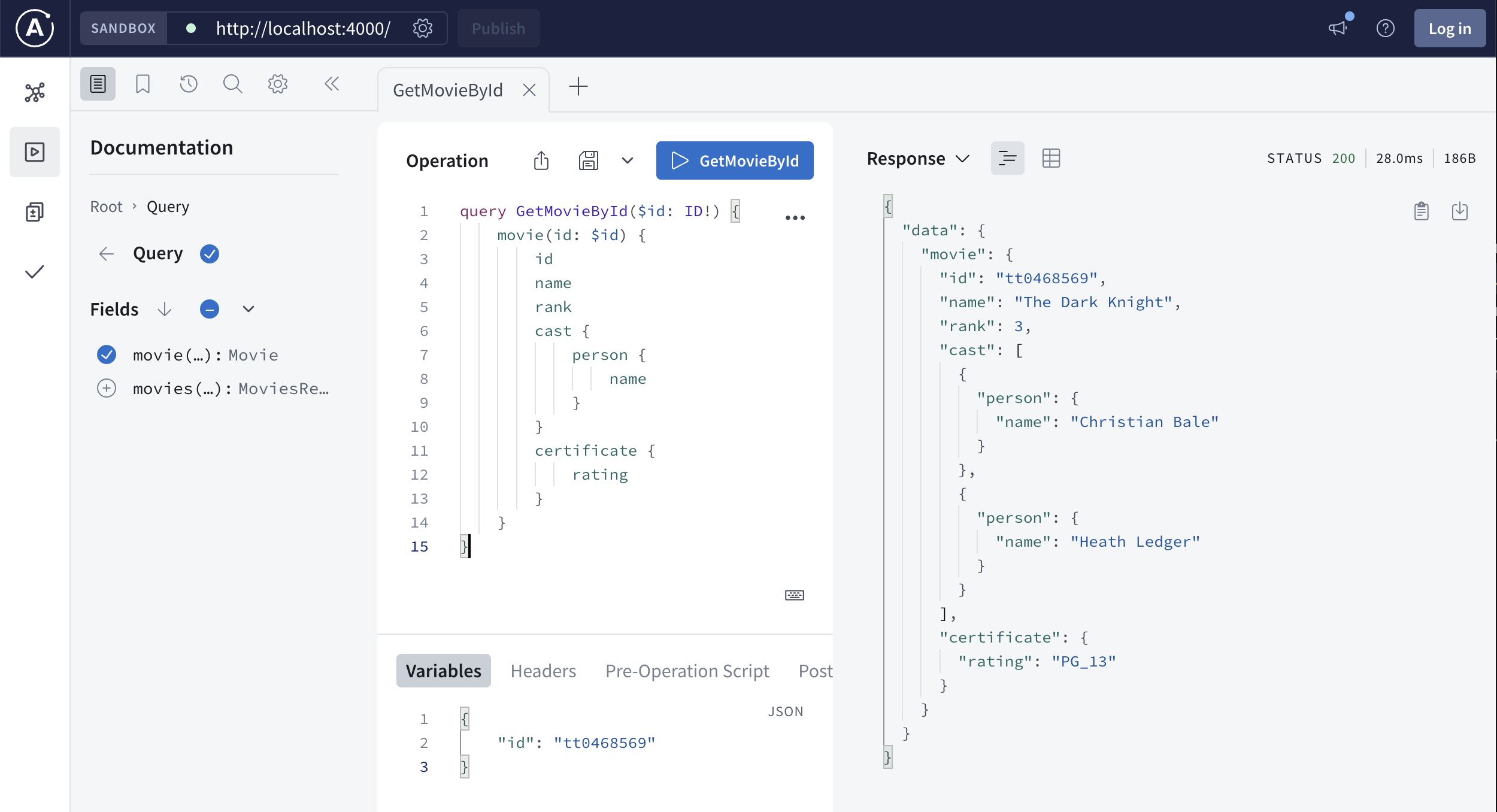Create a GraphQL API
The GraphQL Server plugin generates a starter GraphQL API using Apollo Server. You can then modify this API to meet your requirements. The plugin uses the following key technologies:
- Framework: Apollo Server
- GraphQL code generation: graphql-codegen
- Linting: Code Shaper ESLint configuration & graphql-eslint
You can add additional libraries and frameworks depending on your needs.
This section provides basic instructions for generating the starter GraphQL API. We'll then customize the API to return top 10 movies as required by the Movie Magic application discussed in other sections. You can find the completed example here.
Prerequisite
Make sure that you have the movie-magic repository set up as described in
Create a new repo.
Install GraphQL Server plugin and generate a starter API
Install Code Shaper plugin for GraphQL Server.
npm install @code-shaper/graphql-server
Now generate a GraphQL Server. By convention, servers are created in the apps directory. Let's create one there.
npx shaper
? Which plugin would you like to run? GraphQL Server
? Which generator would you like to run? apollo-server
? Application name? movie-magic-graphql-api
? Parent directory? apps
? Package name used for publishing? @movie-magic/movie-magic-graphql-api
Execute the following commands build and run the server:
# Install dependencies:
npm install
# Build and run the server
npm run build
npm run dev
Point your browser to http://localhost:4000/. You should see the Apollo
Sandbox. Paste the following query in the Operation section of the sandbox
and click the GetMovies button.
query GetMovies {
movies {
id
name
year
rating
}
}
You should see a list of 10 movies in the Response section.

This verifies that the starter GraphQL API is working correctly. Now commit this version.
git add .
git commit -m "chore: add movie-magic-graphql-api"
The GraphQL API is now ready to be customized to your needs.
Enhance the GraphQL schema
The starter API returns all 10 movies contained in movies.json (at
apps/movie-magic-graphql-api/src/datasources/movies.json). We want to enhance
the API to filter, sort and paginate the movies. Let's build this functionality
step-by-step.
We'll start by updating the GraphQL schema to support a richer Movie model. This will enable us to work with more realistic data to test filtering, sorting and pagination. Here's the domain model for the enhanced Movie entity. Note that we have introduced cast members, directors and writers as a new Person entity.

To implement this Movie model, overwrite the schema.graphql file in your
apps/movie-magic-graphql-api/src/gql folder from the schema.graphql file in
the completed example.
When copying files from the completed example, do take a minute to understand them. They are well commented, so it should be easy to understand what they are doing.
Run a build to generate code from the enhanced schema.
npm run build
This will generate new resolver types in
apps/movie-magic-graphql-api/src/generated/resolvers-types.ts. Also note that
the build fails at this point because the existing code is not compatible with
the new resolver types. We will fix this in the following sections.
Enhance the data sources
Copy the following 4 files from
the completed example
into the folder apps/movie-magic-graphql-api/src/datasources (you will be
overwriting 2 files):
movies.json: enhanced movie data (note that this data contains references to cast members, directors and writers which are persisted in thepeople.jsonfile)MoviesApi.ts: API to fetch movie data from themovies.jsonfile (you can think of this as a back-end service that fetches data from a movies database)people.json: people data for cast members, directors and writersPeopleApi.ts: API to fetch people data from thepeople.jsonfile
You can read more about data sources here.
We also need to add PeopleApi to the DataSourceContext, so that an instance
of this API can be passed to the resolvers. Update
apps/movie-magic-graphql-api/src/types/DataSourceContext.ts as follows:
import type { MoviesApi } from '@/datasources/MoviesApi';
+ import type { PeopleApi } from '@/datasources/PeopleApi';
// This interface is used with graphql-codegen to generate types for resolvers context
export interface DataSourceContext {
dataSources: {
moviesApi: MoviesApi;
+ peopleApi: PeopleApi;
};
}
Finally, we need to create an instance of PeopleApi and add it to the context.
Update apps/movie-magic-graphql-api/src/index.ts as follows:
import { MoviesApi } from './datasources/MoviesApi';
+ import { PeopleApi } from './datasources/PeopleApi';
...
context: async () => ({
dataSources: {
moviesApi: new MoviesApi(),
+ peopleApi: new PeopleApi(),
},
}),
...
Update resolvers
Now that we have the backend set up, let's enhance the resolvers to use it.
Overwrite the following 2 files from
the completed example
into the folder apps/movie-magic-graphql-api/src/resolvers:
Query.ts: resolvers for the movie queriesMutation.ts: resolver for the new movie mutationsetFeaturedMovie
You can read more about resolvers here.
Verify the new API
Execute the following commands build and run the server:
npm run build
npm run dev
Point your browser to http://localhost:4000/.
Get Movie by ID
Paste the following query in the Operation section of the sandbox:
query GetMovieById($id: ID!) {
movie(id: $id) {
id
name
rank
cast {
person {
name
}
}
certificate {
rating
}
}
}
Paste the following JSON in the Variables section of the sandbox:
{
"id": "tt0468569"
}
Click the GetMovieById button. You should see the movie named "The Dark Knight" in the Response section.

Get movies by certificates
Paste the following query in the Operation section of the sandbox:
query GetMoviesByCerts($input: MoviesRequest!) {
movies(input: $input) {
movies {
name
certificate {
rating
}
}
pageInfo {
totalPages
totalItems
page
perPage
hasNextPage
hasPreviousPage
}
}
}
Paste the following JSON in the Variables section of the sandbox to get movies with PG or R certifications only:
{
"input": {
"filterSpec": {
"certs": ["PG", "R"]
}
}
}
Click the GetMoviesByCerts button. You should see 8 movies in the Response section, 7 certified as "R" and 1 certified as "PG".
Get top 10 movies
Paste the following query in the Operation section of the sandbox:
query GetTop10Movies($input: MoviesRequest!) {
movies(input: $input) {
movies {
name
rank
}
pageInfo {
totalPages
totalItems
page
perPage
hasNextPage
hasPreviousPage
}
}
}
Paste the following JSON in the Variables section of the sandbox to sort movies by rank and return the first 10:
{
"input": {
"sortSpec": "RANK_ASC",
"pageSpec": {
"page": 1,
"perPage": 10
}
}
}
Click the GetTop10Movies button. You should see 10 movies in the Response section, ranked 1 to 10.
Set featured movie
Paste the following mutation in the Operation section of the sandbox:
mutation SetFeaturedMovie($input: SetFeaturedMovieRequest!) {
setFeaturedMovie(input: $input) {
recordId
record {
name
isFeatured
}
errors {
... on NotFoundError {
message
}
}
}
}
Paste the following JSON in the Variables section of the sandbox to set
movie tt0468569 as featured:
{
"input": {
"movieId": "tt0468569",
"isFeatured": true
}
}
Click the SetFeaturedMovie button. You should see the movie in the
Response section, with isFeatured set to true.
Commit your code
# Commit
git add .
git commit -m "feat: customize movies API with filters, sort and pagination"
Congratulations! You have successfully built a custom movies API using GraphQL in just a few minutes. This is the power of Code Shaper.